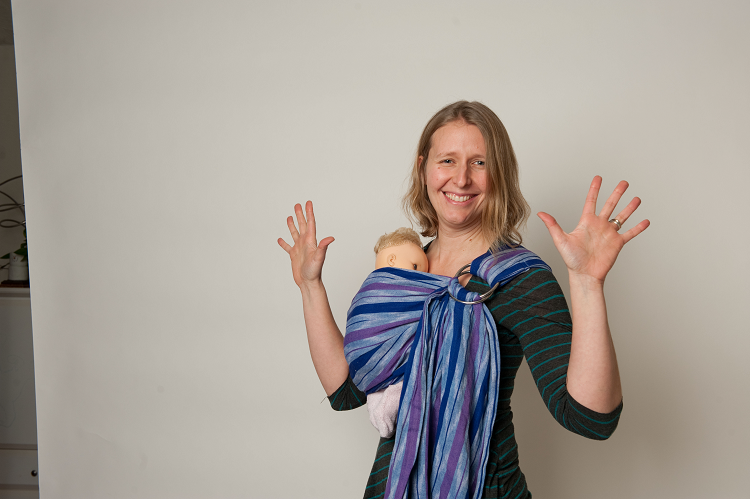
Ring Slings & Babywearing
The array of baby carriers out there in the world can be dizzying. There are so many choices that a new parent may feel overwhelmed and unsure of what to use. While I feel that nearly all soft carriers are great for babies and caregivers, I have a special affection for ring slings, especially for very young babies. Here are some reasons I encourage parents of new babies to give ring slings a try.
Ring Slings are Simple and Soothing
Once you know how the ring slings work and have a little practice, it’s easy to use, and FAST! They do not drag on the ground or require multiple buckles or straps. Ring slings can be used over or under coats/sweaters. In addition, a ring sling counts as one layer of clothing for baby, so it may even make dressing your baby easier. Activities of daily living such as eating breakfast or even using the bathroom at home become much more relaxed. Quick trips out of the house such as visits to the grocery store can be worry-inducing for new parents, who may wonder how to soothe baby if they cry during an outing. Your sling will likely be a big help here! Babies who are worn for several hours per day cry up to 50% less[1], so wearing your baby in a sling may be preventing stress for both of you.
Ring Slings Have a Newborn-Friendly Shape
How are newborn babies different from older babies? For one, they have a very curved spine, leftover from their cozy, curled up womb time. It takes time for the spine to straighten, and the sling supports baby’s spine in its existing shape. The soft fabric, when tightened correctly, supports baby as they change and grow. Babies at this age are working on developing strong neck muscles, and the sling gives them lots of opportunity to practice looking up at their caregivers, a version of tummy time! When baby gets tired, they can be tucked in all way up to their little ears so their wearer can be mostly hands-free. The sling supports baby in a way that promotes healthy hip development. Carrying baby in an “M” position, with their knees up and their bottom down keeps hips in a very safe position, even for babies who may be at risk for hip problems such as dysplasia[2].
Ring Slings are Adjustable
This is an especially wonderful feature of ring slings. It allows them to be easily shared between baby’s parents and any other caregivers. Adults (and babies) come in all shapes and sizes, and those shapes and sizes can change frequently after birth for many reasons, one of which being breast size changes as milk supply regulates. The adjustability allows for different clothing choices, and even for adjusting baby’s position for feeding in the carrier! Yes, it may be possible to breast or bottle feed in your sling.
Slings do have a learning curve like most infant care activities. I feel confident that with quality teaching and frequent practice, your experience will get easier and more enjoyable. Best of luck on your babywearing journey!
About the Author
Laura McCarthy (pictured above) has been babywearing for almost 14 years, starting this wonderful practice with her own two children. She is the owner of Wear Your Little One, Pittsburgh’s first professional babywearing education service, providing group classes and private lessons about all types of baby carriers. Around town, you may find Laura teaching group babywearing classes at the Midwife Center or volunteering at the Three Rivers Free Clinic for the People, providing free 1:1 babywearing support and carriers. Laura also works as a DONA certified postpartum doula, supporting Pittsburgh-area families in the early postpartum period. Laura is a licensed clinical social worker, and facilitates Out of the Blue, a weekly perinatal support group for mothers. Learn more about Laura and all that she offers at www.wearyourlittleone.com, or contact Laura at info@wearyourlittleone.com.
[1] Hunziker UA, Barr RG., (1986), Increased carrying reduces infant crying: a randomized controlled trial. Pediatrics. 77(5):641-8.
[2] https://hipdysplasia.org/developmental-dysplasia-of-the-hip/baby-wearing/
Find more resources and articles here!
